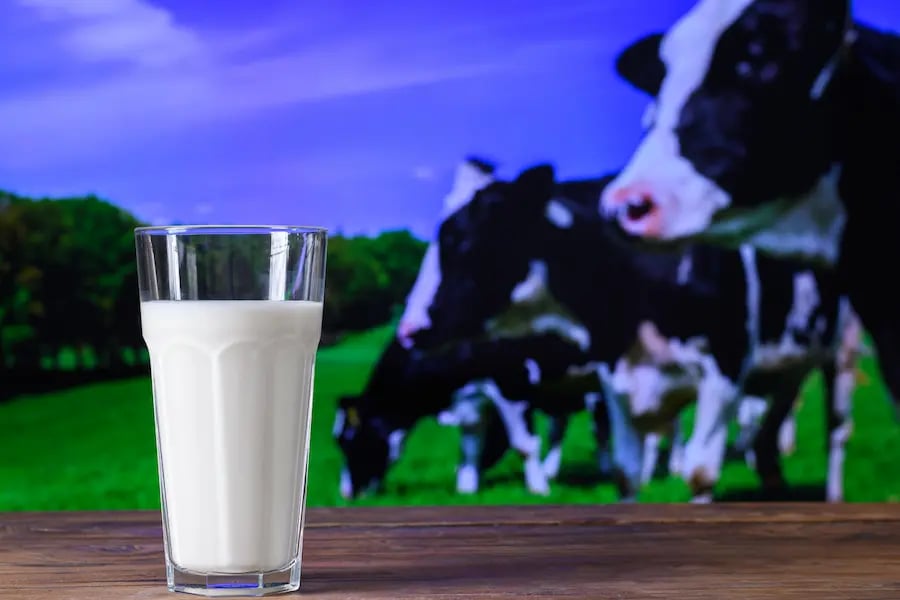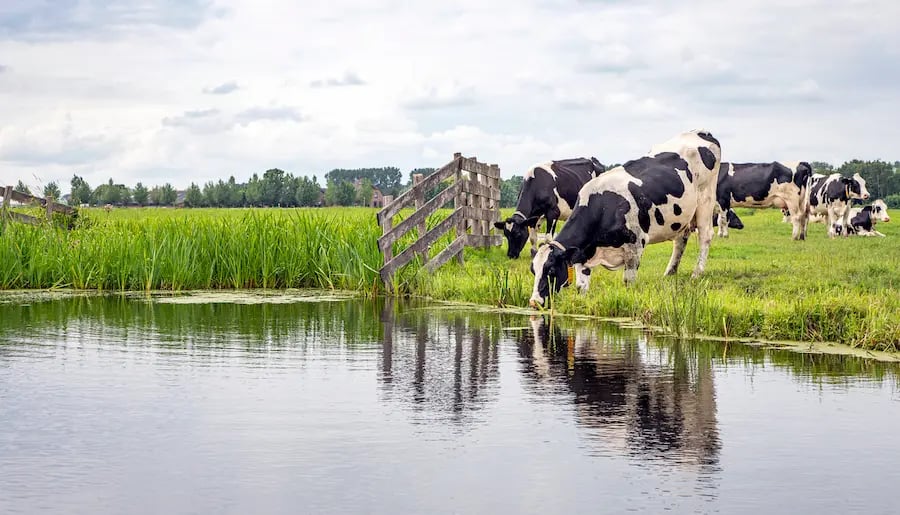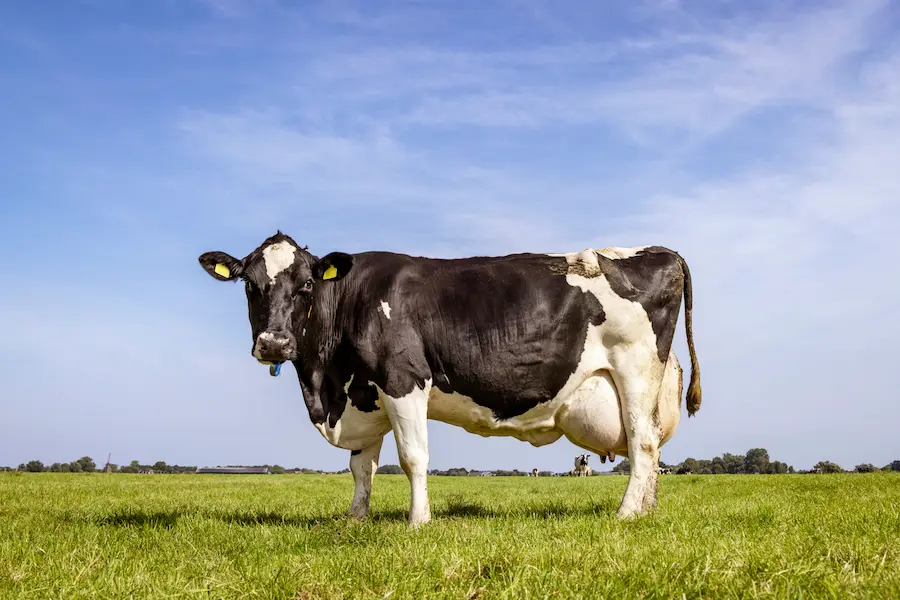Water is a finite resource, essential for the life of humans, animals and plants. After oxygen, it is the most important essential nutrient for living beings.
It is the largest body constituent of mammals and is essential for maintaining life and health.[1]
For dairy cows, water is the most important quantitative feed requirement. The water must be clean, fresh, contain low levels of solids and alkalinity and free of toxic compounds. Thus, on a dairy farm, water is a priority.
Importance of water for dairy cows
Water is used by dairy cows for several purposes, including:
- Digestion: cows are ruminant animals, that is, they have a stomach divided into 4 parts. Water helps break food down into nutrients that can then be absorbed.
- Transport of nutrients: Nutrients from food are absorbed and are transported by the blood to the cells. Water helps keep the blood flowing and thus transport nutrients to the cells.
- Body Temperature: Dairy cows are warm blooded animals, which means they need to keep their body temperature high. The water helps to regulate the cow's body temperature so that she sweats and breathes.
- Excrete Waste: Cows excrete their waste through salivation, urine, feces and sweat. Water helps to dissolve waste and keep it flowing through the cow's body so it can be excreted.
- Essential component of milk: milk is composed of water, lactose, proteins, fat, calcium, phosphorus, and other nutrients. Water makes up about 87% of the total volume of milk.

Low water intake and its consequences
The daily amount of water required by dairy cattle is influenced by several factors, such as ambient temperature, live weight, age, stage of life of the animal (growth, fattening, lactation) and metabolic activity rate, which will largely correspond to the level of production of the dairy cow in each phase of the production cycle. One of the main symptoms of insufficient water intake is a drop in feed consumption. Other signs may be dehydration, increased heart rate, increased body temperature, increased respiratory rate and a state of lethargy, simultaneously becoming more susceptible to illness and more passive. Without water, the basic metabolism of animals is put at risk, seriously affecting the functionality of the main organs. Often overlooked, water is essential for the health and well-being of animals.[2]
On average, it is important to note that in a pasture system, lactating cows drink around 64 liters of water per day; in the semi-confined system around 48 liters of water per lactating cow per day and in the confined system they drink 89 liters.
If water consumption per liter of milk/day is related, the values for the different models vary from 3.3 liters of water per liter of milk per day in the grazing regime and 3.8 liters of water per liter of milk per day in the confined regime.
As for the ambient temperature, it is known that for each increase of 1ºC, there is an increase of 1.2 liters of ingested water. The ambient temperature must always be evaluated together with the humidity, because in a more humid climate, dairy cows have greater difficulty in dissipating heat and can enter thermal stress, even if the environmental temperature is low. Therefore, the reference is made that cows are more comfortable with temperatures between 15 and 21ºC and with humidity not exceeding 70%. [3]
Amount of body water according to the physiological state of the dairy cow
The percentage of body water depends on the physiological state of the dairy cow. In a tropical climate or in the hottest months of a temperate zone, consumption increases, as the cows suffer heat stress and increased temperature, with a consequent increase in urine excretion and a change in the composition of the manure. The amount of water ingested follows the consumption of the food, and the peak consumption coincides with the peak consumption of dry matter, even if the food is offered several times a day. Another consumption peak is observed after milking, which can represent 40% to 50% of the total daily consumption.[1]

Dairy cows have about 56% to 81% of their weight made up of water. The physiological state and body composition of the animal affect the total amount of water in the body. So, and more concretely:
- Younger, leaner cows have a higher body water content whereas older, fatter cows have a lower body water content.
- Dry cows, in advanced pregnancy, present 64.7% of their live weight in water.
- Cows in early lactation have 69% of their body weight in water.
- Cows in more advanced lactation have 62.4 body weight in water. [3]
Drinkers for dairy cows
The number of times the cow goes to the drinker is not a determining factor for the amount of water ingested, as this is directly related to the intake in each drink and not with the number of drinks per day.
It is important to provide dairy cows with fresh, clean water ad libitum. The water must be free of impurities and at room temperature. The following points regarding drinkers are highlighted:
- Keep water fountains clean and in good working order.
- The water flow in the drinkers must allow it to be renewed at least twice a day.
- Make sure the water is fresh and tepid.
- Place the drinkers in shaded and wind-protected places.
- Drinkers must have appropriate dimensions so that a greater number of adult cows can drink water at the same time.
- Monitor the water consumption of dairy cows to ensure they are drinking enough.
Water quality
The water must be clean and fresh. Contamination, even a small one, can have harmful consequences for the animal, including the healthiness of the milk. When talking about water quality we are talking about both the water used for cleaning the milking equipment and the water for drinking. If the water is contaminated, it can affect animal health and well-being and, therefore, this contamination can be transferred to foodstuffs (milk and meat), jeopardizing human health. The most common contaminants are microorganisms and their toxins, viruses, protozoa and parasite eggs, as well as pesticides, nitrates, solvents and fuels.
It is important to note that the water can come from natural sources or even from the public supply network and this must be of good quality to the detriment of the dairy cow starting to ingest water or even refusing to ingest it and consequently verify reducing food intake.
Therefore, in summary, the water used in dairy farms must be colorless and odorless, so that the animals ingest the amount of water they want. Water from wells, mines, dams, rivers and lakes is often not suitable for consumption, so it is essential to treat the water properly for later use. Furthermore, water must be frequently subjected to physical-chemical, microbiological and even radioactive analyses.[4]
Conclusion
Water is a very important nutrient for dairy cows, as it performs several functions, including nutrient transfer, waste excretion, body temperature regulation, and growth. Water intake in dairy cows is influenced by both animal-related factors (breed, body size, physiological stage, age, health, stress, and ecological adaptations) and environmental factors (weather, season, ambient temperature, humidity, wind, and precipitation). Management practices such as dairy cow rearing, feeding practices, housing, water availability, and water quality can also indirectly affect water intake.
Water is essential for dairy cow health and productivity. It is important to ensure that cows have access to clean, fresh water always.
References
[1] A. Torres de Campos, “Importância da água para bovinos de leite,” Embrapa-gado de leite, Brasil, Mar. 2006. Accessed: Aug. 11, 2023. [Online]. Available: https://www.embrapa.br/gado-de-leite
[2] J. Lima Cerqueira, “A importância da qualidade da água e da higienização dos bebedouros,” AGROS. Accessed: Aug. 11, 2023. [Online]. Available: https://www.agros.pt/artigos/a-importancia-da-qualidade-da-agua-e-da-higienizacao-dos-bebedouros/
[3] G. Filgueiras, “Ingestão de água por bovinos de leite: saiba tudo sobre a importância deste nutriente,” PRODAP. Accessed: Aug. 11, 2023. [Online]. Available: https://blog.prodap.com.br/agua-para-bovinos-de-leite/
[4] D. M. Golher, B. H. M. Patel, S. H. Bhoite, M. I. Syed, G. J. Panchbhai, and P. Thirumurugan, “Factors influencing water intake in dairy cows: a review,” Int J Biometeorol, vol. 65, no. 4, pp. 617–625, 2021, https://www.doi.org/s00484-020-02038-0
About the author
Ana Vanessa Dias Sousa (Researcher FeedInov CoLAB)
With a degree in Veterinary Sciences from the University of Trás-os-Montes and Alto Douro, she worked for five years as a field veterinarian and in a pig and cattle feed factory. She worked in the pharmaceutical industry as a sales manager and technical support for pigs, cattle, rabbits and poultry in mainland Portugal and the Azores. She is currently at Feedinov Colab as a Researcher in the One Health Department.
Explore author’s articles



Leave your comments here